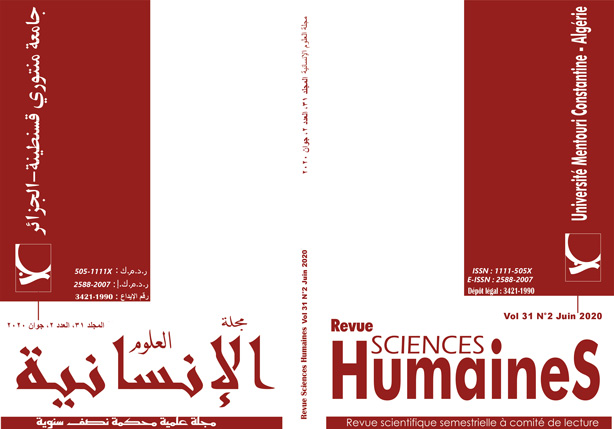Diglossic switching by the Pre-school Children.
The Case of ‘Dib Tahar’ Primary School
الكلمات المفتاحية:
Algerian Arabic، code switching، diglossia, diglossic switching، Modern Standard Arabicالملخص
The present study aims at investigating children’s switching between Modern Standard Arabic and Algerian Arabic. To reach this aim, an ethnographic approach is followed with pre-school children aging six years old at ‘Dib Tahar’ primary school at Elkroub, Constantine- Algeria. It is based on triangulation: participant observation, recordings, and an interview with the teacher of the sample. The results reveal that pre-school children do switch between the varieties of Arabic in the class and they may deviate from the standard pronunciation of the Algerian words to express themselves. Intra-word switching is very common in their speeches.Further, Children’s switching is rule-governed. The results obtained challenge Ferguson’s definition of diglossia and call for reconsidering the separation of its domains.
التنزيلات
المراجع
. Ahmed Othman, M. (2006). Language Choice among Arabic-English Bilinguals in Manchester, Britain. Unpublished Doctoral Dissertation. Manchester: University of Manchester.
. Bassiouney, R. (2009). Arabic Sociolinguistics. Edinburgh: Edinburgh University Press.
. Benlaksira, F. (2019). Direct and Indirect Lexical Origins of the Dialect of Constantine. Sciences Humaines (50), 35-55.
. Gardner-chloros, P. (2009). Code-Switching. Cambridge: cambridge University Press.
. Genesee, F., & Nicoladis, E. (2007). Bilingual First Language Acquisition. In E. Hoff, & M. Shatz, Blackwell Handbook of Language Development. Malden: Blackwell Publishing Ltd.
. Harklau, L. (2005). Ethnography and Ethnographic Research on Second Language Teaching and Learning. In E. Hinkel, Handbook of Research in Second Language Teaching and Learning. London: Lawrence Erlbaum Associates, Publishers.
. Harrat, S., Meftouh, K., Abbas, M., Hidouci, K., & Smaili, K. (2016). An Algerian Dialect:Study and Resources. International Journal of Advanced Computer Science and Applications , 7 (3), 384-396.
. Kormos, J. (2006). Speech Production and Second Language Acquisition. new Jersey: Lawrence Erlbaum Associates.
. Le Roux, C. (2017). Language in Education in Algeria: a historical vignette of a 'most severe' sociolinguistic problem. Language & History , 60 (2), 112-128.
. Mckay, S. (2006). Researching Second Language Classrooms. London: Lawrence Erlbaum Associates, Publishers.
. Moshref, O. (2013, April). Approaches to Diglossic Mixing in Spoken Arabic-Review of some Corpus Studies-. Research Gate , 1-20.
. Mouleme, M. (2012). Attitudes towards the Teachers' Use of Code Switching in EFL Classrooms. Unpublished Magister Dissertation : University of Jijel .
. Mouleme, M., Ahdi, H., & Hakim.A.B. (2019). Learners’ Attitudes towards Teachers’ switching to themother tongue (The Case of Secondary school learners. Indonesian TESOLl Journal , 1 (1), 9-26.
. Muysken, P. (2000). Bilingual Speech: A Typology of Code-Mixing . Cambridge: Cambridge University Press.
. Rauguenaud, V. (2009). Bilingual by Choice: Raising Kids in Two (or more!) languages. Boston: Nicholas Brealey Publishing.
. Sabir, H., & Safi, S. (2008). Developmental Diglossia: Diglossic Switching and the Equivalence Constraint. JKAU: Arts & Humanties , 16 (2), 91-110.
. Sayahi, L. (2014). Diglossia and Language Contact: Language Variation and Change in North Africa. Cambridge: Cambridge University Press.
.فتيحة باشى ، رابحة طاقين ، نادية صديق.(2015).التعليم التحضيري التحصيل الدراسي لدى تلاميذ السنة الاولى ابتدائي في مادة اللغة العربية. مذكرة تخرج لنيل شهاذة الليسانس : جامعة طاهر مولاي سعيدة..
التنزيلات
منشور
كيفية الاقتباس
إصدار
القسم
الرخصة

هذا العمل مرخص بموجب Creative Commons Attribution-NonCommercial-ShareAlike 4.0 International License.
















